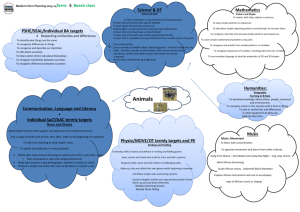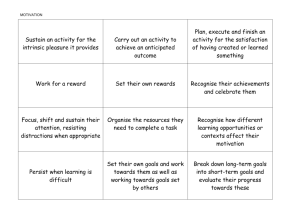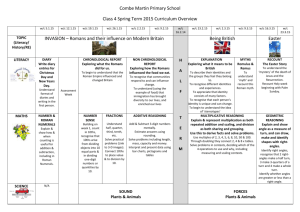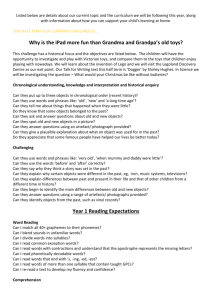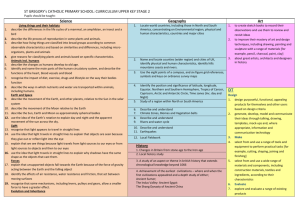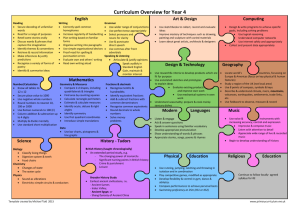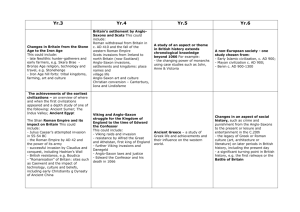History
advertisement
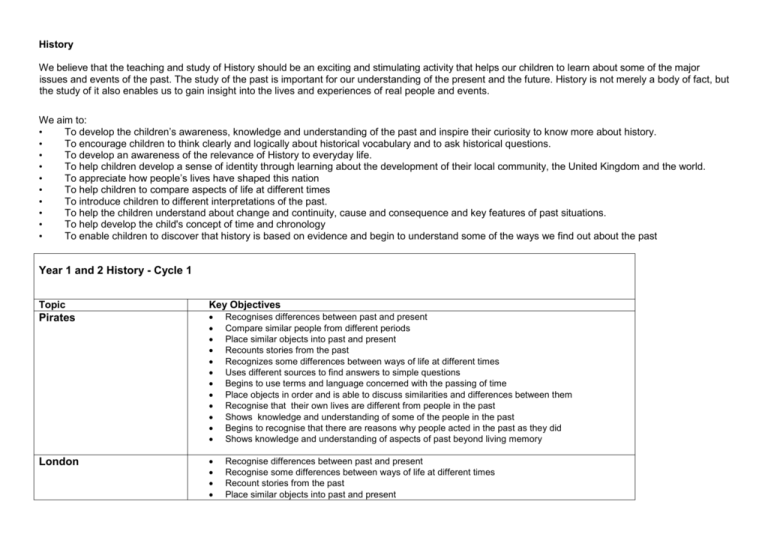
History We believe that the teaching and study of History should be an exciting and stimulating activity that helps our children to learn about some of the major issues and events of the past. The study of the past is important for our understanding of the present and the future. History is not merely a body of fact, but the study of it also enables us to gain insight into the lives and experiences of real people and events. We aim to: • To develop the children’s awareness, knowledge and understanding of the past and inspire their curiosity to know more about history. • To encourage children to think clearly and logically about historical vocabulary and to ask historical questions. • To develop an awareness of the relevance of History to everyday life. • To help children develop a sense of identity through learning about the development of their local community, the United Kingdom and the world. • To appreciate how people’s lives have shaped this nation • To help children to compare aspects of life at different times • To introduce children to different interpretations of the past. • To help the children understand about change and continuity, cause and consequence and key features of past situations. • To help develop the child's concept of time and chronology • To enable children to discover that history is based on evidence and begin to understand some of the ways we find out about the past Year 1 and 2 History - Cycle 1 Topic Key Objectives Pirates Recognises differences between past and present Compare similar people from different periods Place similar objects into past and present Recounts stories from the past Recognizes some differences between ways of life at different times Uses different sources to find answers to simple questions Begins to use terms and language concerned with the passing of time Place objects in order and is able to discuss similarities and differences between them Recognise that their own lives are different from people in the past Shows knowledge and understanding of some of the people in the past Begins to recognise that there are reasons why people acted in the past as they did Shows knowledge and understanding of aspects of past beyond living memory London Recognise differences between past and present Recognise some differences between ways of life at different times Recount stories from the past Place similar objects into past and present Seaside Place simple events in chronological order Use simple vocabulary to describe the passing of time Uses different sources to find answers to simple questions Place events and objects in order and discuss similarities and differences between them Recognise that their own lives are different from people in the past Show knowledge and understanding of some of the events and people in the past Begins to recognise that there are reasons why people acted in the past as they did Shows knowledge and understanding of aspects of past beyond living memory and recounts stories Place similar objects into past and present. Place simple events in chronological order. Use simple vocabulary to describe the passing of time. Recognises differences between past and present. Begins to use terms and language concerned with the passing of time. Place events and objects in order and is able to discuss similarities and differences between them. Recognise that their own lives are different from people in the past. Shows knowledge and understanding of aspects of past beyond living memory. Begins to show their own interpretation of events through activities such as role play, pictures and writing. Year 1 and 2 History - Cycle 2 Topic Ourselves Key Objectives Recognises differences between past and present Use simple vocabulary to describe the passing of time Place simple events in chronological order Place similar objects into past and present Recognizes some differences between ways of life at different times Uses and handles different sources to find answers to simple questions Place events and objects in order and is able to discuss similarities and differences between them Recognise that their own lives are different from people in the past Shows knowledge and understanding of aspects of past beyond living memory Castles Place simple events in chronological order Recounts stories from the past Recognizes some differences between ways of life at different times Uses different sources to find answers to simple questions Place events and objects in order and is able to discuss similarities and differences between them Recognise that their own lives are different from people in the past Shows knowledge and understanding of some of the events and people in the past Begins to recognise that there are reasons why people acted in the past as they did Shows knowledge and understanding of aspects of past beyond living memory and recounts stories Begins to use terms and language concerned with the passing of time Place events and objects in order and is able to discuss similarities and differences between them Recognise that their own lives are different from people in the past Shows knowledge and understanding of some of the events and people in the past Begins to recognise that there are reasons why people acted in the past as they did Shows knowledge and understanding of aspects of past beyond living memory and recounts stories Begins to show their own interpretation of events through activities such as role play, pictures and writing Handles or observes sources of information to answer questions about the past on the basis of simple observations Communicate their knowledge and understanding in a variety of ways Brazil Year 3 & 4 History – Cycle 1 Topic Changes in Britain from the Stone Age to the Iron Age Key Objectives late Neolithic hunter-gatherers and early farmers (e.g, Skara Brae) Bronze age religion, technology and travel (e.g. Stonehenge) Iron age hill forts, tribal kingdoms, farming, art and culture The Celtic people, their homes, lifestyle and beliefs Use terms before and after-1000, 2000 years ago, ancient, pre-history Realize that the past can be divided into different periods of time Describe some characteristic features of periods studied Select and record information from a single source relevant to the focus of the enquiry (y3); Select and combine information from different sources (y4) The Roman Empire and its impact on Britain To understand importance of archaeology in our knowledge of past that history is based on evidence be able to place Celtic and Roman periods in a chronological framework use terms –ancient, century, A.D. B.C. use the terms “invade” and “settle Use variety of sources to find out about Roman soldiers: their armour, weapons, discipline etc know main events and causes of Roman invasions and settlement of Britain know the main events of Boudicca’s revolt different interpretations of the revolt Compare Celtic and Roman houses investigate life in Roman times, including main features of Roman towns be able to give some examples of changes that took place during the Roman period The Second World War know when WW2 took place begin to understand why it happened explain how Britain prepared for war use a range of sources to find out about experiences of evacuees know why rationing was introduced investigate the impact of rationing on the way of life of people living during WW2 know how the local area was affected by WW2 use extracts from school log-book to find out about experiences of WW2 in local area Select and combine information from different sources Represent information in a variety of ways Key Objectives Recognise Anglo-Saxon period as period of history Place Roman and Saxon periods in chronological order Know that Romans withdrew from Britain in c. AD 410 Know the main Anglo-Saxon tribes who settled in Briton and where they came from Use term invade and settle investigate invasions, settlements and kingdoms: evidence from place names describe features of villages in Saxon times Year 3 & 4 History – Cycle 2 Topic Britain’s settlement by Anglo-Saxons and Scots The Viking and Anglo-Saxon struggle for the Kingdom of England to the time of Edward the Confessor The achievements of the earliest civilizations know evidence that Bedford was a Saxon town Use a range of sources to investigate aspects of Anglo-Saxon life, such as art, culture, laws and justice Identify changes within a period: Christian conversion Viking raids and invasion Who were Vikings? Where did they come from and why? resistance by Alfred the Great further Viking invasions and Danegeld Edward the Confessor and his death in 1066 Ancient Egypt locate Ancient Egypt in time How much of the life of Egypt depended on the Nile To make deductions about life in the past why Egyptians built pyramids what Egyptians believed about afterlife Why bodies were mummified aspects of life in ancient Egypt investigate Ancient Egyptian art archaeology of ancient Egypt – Howard Carter
